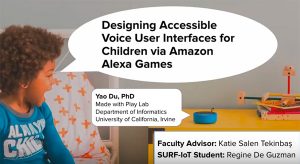
An interdisciplinary team of speech therapists, designers, developers and undergraduate students has developed a voice-activated game for children age 3 to 6.
Aug. 10, 2020
Since its release in 2011, AI-enabled voice assistant smart speakers, such as Amazon Alexa and Apple’s Siri, have been enthusiastically adopted by U.S. consumers. A 2019 report released by Loup Ventures estimated that at the end of 2018, 28 percent of all U.S. households had a smart speaker. They project that by 2025, that figure will have grown to 75 percent – or more than 100 million households.
The technology has inspired researchers and developers to create a vast array of voice-enabled products from smart refrigerators to games that extend conversation engagement.
Yao Du, a Ph.D. candidate in Informatics and SURF-IoT mentor has focused her work on designing and evaluating web, mobile and voice interfaces for bilingual children and children with communication disorders.
“I work with children with disabilities who need help with their speech language and overall communication,” say Du, who has also worked as a licensed speech language pathologist. “We use a lot of different assessments, intervention tools and technology to help children improve their communication.” Once voice technology became widely adopted, she began hearing from parents and clinicians about speech improvements and advances that resulted from children having direct conversations with these smart devices.
“It just fascinated me and inspired me to understand what additional affordances are available via these voice applications and what can I do as a therapist and also a designer to create applications to help children who have disabilities,” she adds.
Du met with SURF-IoT fellows recently to present an overview of her experiences creating voice-user interfaces in games for young children. She is currently working with SURF-IoT fellow and social ecology major, Regine De Guman, and others to study literature focused on human computer interaction, communication science and disorders, and game design as it pertains to virtual assistants.
There are limited studies on usability issues with virtual assistants among children, Du says. Their goal is to identify gaps in prior research and come up with solutions.
Individuals who have visual, motor or cognitive impairment are already capitalizing on these voice-only interfaces, Du notes. “Children with autism and speech impairments are also increasingly using these conversational agents. This allows voice assistant apps to become potential educational tools, but there are few guidelines on how to design an accessible-experience to ensure individuals with a disability are supported rather than hindered in their user-experience, she says.
Du’s interdisciplinary team of speech therapists, designers, developers and undergraduate students has developed a voice-activated game for children age 3 to 6. The game features basic language skills, such as listening to questions and engaging in short conversations.
Speech therapists, designers and developers looked at different facets of the game design. Undergraduate students worked with the clinicians to collect data from playtesting with children. Playtesting data was delivered to the designer and developer to improve the game’s appearance and operation. This summer the group will be designing the voice interface and additional visuals, Du adds.
“I learned that audio design and voice interfaces are both instrumental especially when we think about designing for children as our users,” Du says.
Children benefit from simple to complex progression, she explains. “You want to make it simple and easy to start, but then use the level design to support their challenge and the gameplay goal so they feel motvated.”
Du is also collaborating with researchers at Chapman University to test ways for individuals who are nonverbal (and rely on speech-generating devices and visual icons to communicate) to play the game via a synthesized voice.
“That’s something that no prior research has examined. It’s machine communicating to machine so that’s something super interesting we’re looking at,” Du says.
– Sharon Henry
